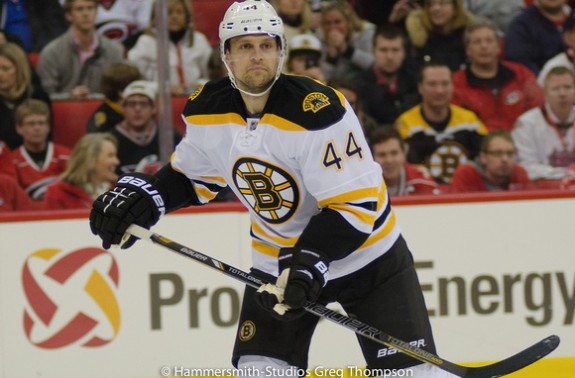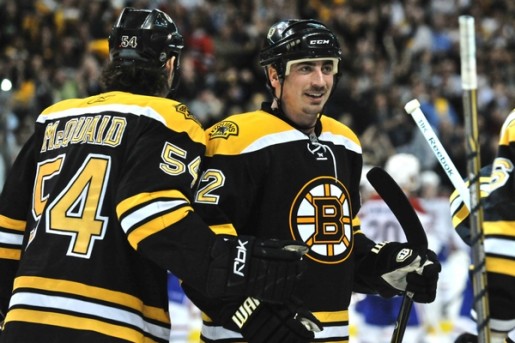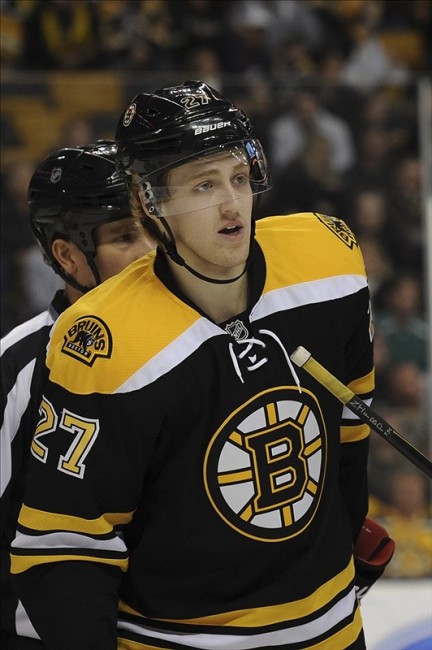When Bruins defenseman Dennis Seidenberg was lost for the season with a torn ACL and MCL in his right knee, the widespread speculation began about what moves Boston had to make. The most common answer was that a trade for a top four defenseman was necessary. That, however, would be a short-sighted move, one that could prove detrimental to the team in the short-term and the long-term.
There is no denying the importance of Dennis Seidenberg to this Boston Bruins team. This is even more apparent when examining his role in the playoffs. Since joining the Bruins in 2010, Seidenberg has participated in three of Boston’s four playoff runs. In 50 playoff games, he’s averaged just under 27 minutes per game, with a combined +14 plus/minus and 15 points. He has slotted next to Bruins captain Zdeno Chara, forming what could be considered the best shutdown defensive duo in the NHL.

With that said, the Bruins find themselves in a slightly different situation this year. In years past, the Bruins have been in need of a defenseman at the trade deadline. Whether that be a depth defenseman or a puck-moving defenseman, a defenseman of some sort could always be found atop Boston’s wish list. While a defenseman will be the primary target this March, a move is in no way necessary, even with the loss of Seidenberg.
For the sake of comparison, let’s take a look at the Bruins defensive group this year compared to each of the last three years, a span that saw the Bruins rank among the best defensive squads in the NHL.
This year (without Seidenberg), the Bruins have Zdeno Chara, Johnny Boychuk, Dougie Hamilton, Torey Krug, Adam McQuaid, Matt Bartkowski, and Kevan Miller.
The 2011 Defensive Group
In 2011, the Bruins were primarily in desperate need of a puck-moving defenseman, but an NHL caliber defenseman of some sort was an absolutely necessity. They had traded Matt Hunwick earlier in the season, leaving them with at least one rookie playing every night. Adam McQuaid, Steven Kampfer, and Matt Bartkowski all saw playing time in Boston as rookies that season. When the Bruins traded Mark Stuart to the Atlanta Thrashers in the deal that netted them Rich Peverley, it became a requirement that they acquire an NHL defenseman. Insert Tomas Kaberle. The Toronto Maple Leafs defenseman was shipped to Boston for Joe Colborne (the Bruins 2008 first round pick) and two draft picks. Kaberle didn’t “wow” anyone during his stay in Boston, but he helped the Bruins win the Stanley Cup. For the playoffs, the Bruins skated Chara with Seidenberg, Boychuk with Ference, and Kaberle with McQuaid.

So how does that stack up to the current Bruins defensive group? Chara is three years older, which hurts a little, although his game has not suffered as dramatically as you might expect from an almost 37 year old defenseman. At the age of 30, Boychuk is currently playing the best hockey of his career, averaging more than 21 minutes a game, while serving as a physical presence on the back end. He’s also on pace for career highs in points and assists. Due, in part, to the injuries on the blue line this season, Adam McQuaid has played bigger minutes than usual, but for the most part, he is still playing the same consistent defensive defenseman role as he was in 2011. The big difference between now and 2011 is the younger defensemen. Torey Krug has showcased his elite offensive skills from the blue line, but struggled to find consistency on the defensive side. He compares favorably to Tomas Kaberle in 2011, giving the Bruins an upgrade on the third pairing. Matt Bartkowski plays a very similar game to Andrew Ference, possessing top of the line skating skills and a developing two-way game. Bartkowski is lacking in the experience department (in comparison to Ference), but he is not a significant downgrade by any means. Dougie Hamilton is still coming into his own at 21, but he has shown a lot of improvement. He’s struggled with some injuries this season, but when he’s played, he’s averaged close to 19 minutes per game. The positive is that between Hamilton and Krug, the Bruins power play is so much better now than they were in 2011. On the down side, defensively, Hamilton can’t replicate what Seidenberg brought to the table, putting a lot more pressure on Chara and Boychuk to elevate their games. As a unit, this Bruins team is better than the 2011 Bruins defensive group, offering a stronger balance of offense and defense.
The 2012 Defensive Group
In 2012, the Bruins struggled as a team, resulting in an early exit from the playoffs at the hands of the Washington Capitals. Between the Stanley Cup Finals in 2011 and the beginning of the playoffs in 2012, the defense went through some changes. In the summer, Kaberle left as a free agent, leading the Bruins to acquire Joe Corvo as a replacement. Although Kaberle was not spectacular as a Bruin, he was better than the 2011-2012 version of Joe Corvo. The Bruins would later trade Steven Kampfer to Minnesota for veteran defenseman Greg Zanon. Zanon provided the Bruins with a reliable, bottom-pairing defenseman, but he did not have a major impact in the playoffs. In a minor move, the Bruins also added Mike Mottau as a depth defenseman at the trade deadline. Mottau played in six regular season games and two playoff games, registering a -2 plus/minus in the postseason.
This season’s defensive group stacks up even better against the 2012 playoff squad. Krug is leaps and bounds ahead of Corvo on both ends of the ice. Matt Bartkowski provides more offensive and better breakout skills than Greg Zanon, making the unit far more mobile. The early returns on Kevan Miller suggest that he will, at the very least, be at replacement level for Mottau, if not a noticeable upgrade as the seventh defenseman. Once again, this leaves Hamilton to fill the shoes of Dennis Seidenberg, a daunting individual task, but certainly more manageable when faced as a group.

The 2013 Defensive Group
This brings us to last season’s group. They went to the Stanley Cup Finals, losing in crushing fashion after failing to hold a late third period lead in game 6. While many people will point to this as a reason for making a trade, I’d argue the exact opposite. Last year, the primary differences were Dennis Seidenberg was in the lineup, as was Andrew Ference, while Matt Bartkowski and Dougie Hamilton were regularly in the press box. Dennis Seidenberg, whether you want to attribute it to age, injury, or the condensed season, really wore down as the playoffs progressed. He was not able to play at the level that the Bruins were accustomed to, leaving much to be desired at both ends of the ice. Despite his subpar performance, the Bruins took it to the best team in the NHL, for the better part of the six game series. Ference was also dealing with injuries, as he missed a number of games throughout the playoffs, opening the door for Bartkowski and Krug to make a name for themselves. Both young defensemen played beyond their years, showing promise for a bright future in Boston. This year, they have an additional season of NHL hockey under their belt, which, when combined with their youth, gives the Bruins a new weapon on the back end. Dougie Hamilton’s time in the press box looks to have paid dividends. He’s shown improvement on the defensive side, but is still willing to jump into the rush on offense, leaving his mark on the scoreboard.
So what does all of this mean? Well, this group of defensemen compares favorably to three previous playoff teams, two of which went to the Stanley Cup Finals, one of which one it all in 2011. Don’t get me wrong, losing Dennis Seidenberg hurts, but this team is well equipped to move forward without him this year. In all likelihood, Peter Chiarelli will make a move (or two) to augment his roster for the playoff push. When that happens, it will not be a move out of desperation, it will be a move that is in the best interest of the short- and long-term goals of the team. If that opportunity doesn’t present itself, the Bruins are better off standing pat, riding it out with the kids that are chomping at the bit for their chance to win the Stanley Cup.